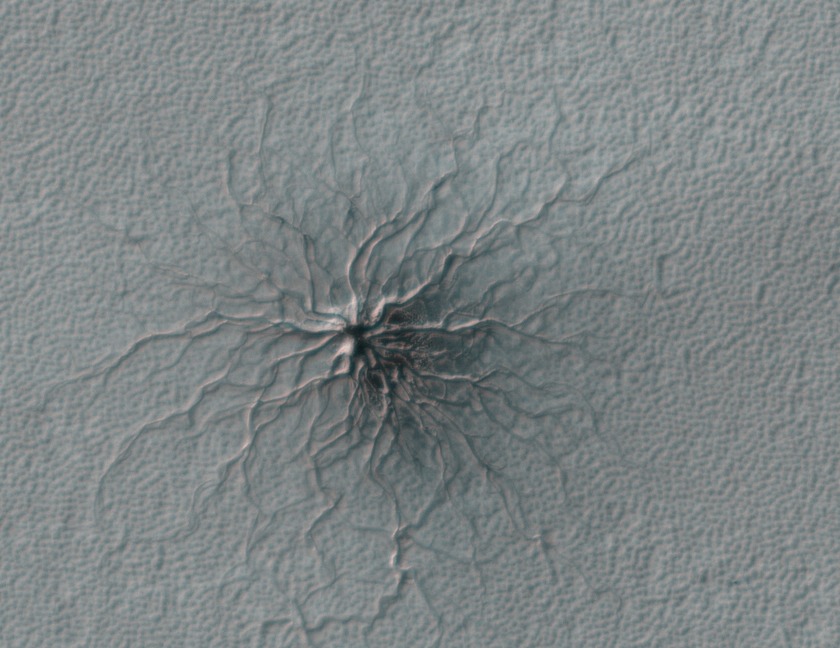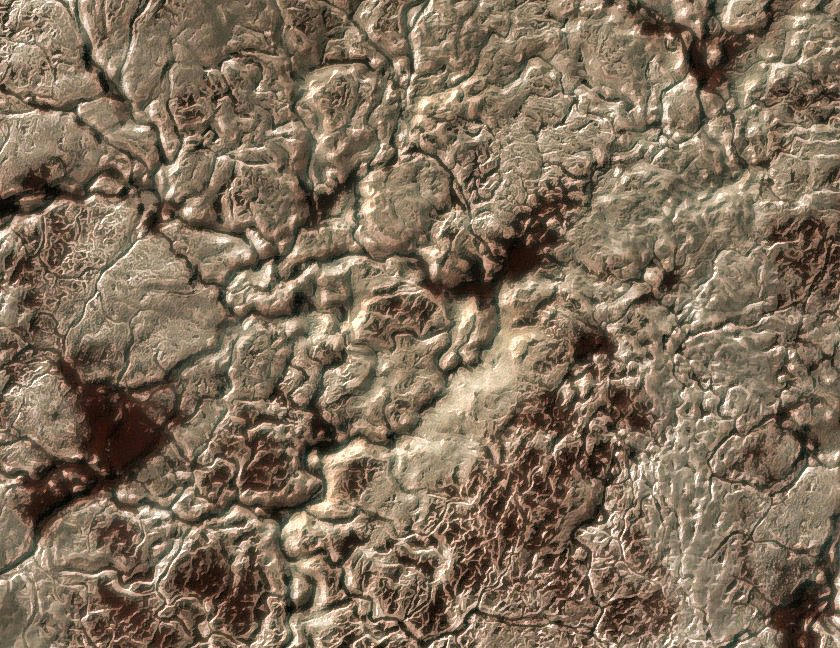Help Identifying Different Types of Spiders
-
 by
mschwamb
scientist, translator
by
mschwamb
scientist, translator
Hiya,
We had a science team telecon at the end of last week where we started talking about what we might be able to do with characterizing the morphology of spiders and the different channels with a version of Planer Four. This is in the very very very early stages of discussion. More like in the information hunting and thinking stage. The science team is starting to think about how we would design a classification interface for this and what science questions about the spiders we could answer with your clicks.
We'd like to enlist your help in this process. We need to have a broad handle on the different types of spiders so we can think about how we might break the different types down into categories that someone would be able to select when classifying.
So that's where you come in. Everyone on Talk has seen lots of cutouts from the HiRISE images, and we bet you've seen spiders the science team hasn't come across. If you can post the APHid or even better link the image into the thread by inserting it using the Talk tool (image link tool is to the right of the 1s and 0s icon) for the different types of spiders and channels you've come across or as you see them that would be fantastic.
As a starter here's what previously the PI of Planet Four, Candy Hansen, prepared for a press release. It's not likely a complete but it's an example of some of the different spider morphology she spotted.
And thanks for your help with this.
Cheers,
~Meg
Posted
-
 by
mschwamb
scientist, translator
by
mschwamb
scientist, translator
I thought I'd start - Wassock showed these lovely 'baby' spiders as he called them:
from full HiRISE frame ESP_029048_0925
Cheers,
~Meg
Posted
-
 by
wassock
moderator
by
wassock
moderator
Hi Meg, new game. My 3 penneth worth, for what is worth.
Don't know if it is significant but seems to me that the baby spiders have a fairly consistent form, generally with 3 legs. And theres an issue with them as candidates for spiders in the early stages of formation as they dont seem to be associated with the fans that form all around them,
As to types of spiders I'd suggest that you keep tabs on where the spiders come from. In the same way that the fans can be distinctive of an area so also might the spiders. What the surface is made of will likely be important too.
I think theres also a difference between the classic spiders, which dont appear to have a surface precursor and the lace type spiders which seem to come from pre existihg surface features.
Kitharode spent some time in the early days kicking classification around so he may already have some outline of a system
Posted
-
 by
Kitharode
moderator
in response to mschwamb's comment.
by
Kitharode
moderator
in response to mschwamb's comment.
Nice of wassock to remember the spider classification scheme (SCS). We had a lot of fun with it and I learnt a lot about how hard a job this would be to do properly. 😉
I agree with everything that wassock says above. Location and surface type (general landscape) would be useful as a context for the spiders identified. 'Classic' and 'Lace' type spiders do seem to be good candidates for looking at the 'origins' of these types of channels. I would suggest (by guesswork) that the baby spiders (often 3-legged, looks like Greek writing) are in the minority when it commes to number of examples and they definately deserve a category of their own. It'd be good to get a feel for relative numbers of babies and adults in different locations.
There's a lot to like about Candice's examples. The images scaled at 1km across look like a good idea. More chance of catching the whole spider, or group of spiders, than with the P4 cutouts. Is the image size fixed for this exercise, or can it be changed? Candice also notes the difference between classics and lace terrain. But there are different types of classics, different types of lace, and different ways of describing them ... and so it begins to get complicated.
One suggestion from the early SCS which got some support was to place the channels into one of two groups: Spider or Web. If it looked spidery it went in Spider, if it looked like ropes, nets, or lace it went in Web. (Might need an 'Other' group as well).
Ideally, as a punter I'd like to do some multi-choice clicks on an image and let the interface take me further down the classifying route if I want to carry on that far. Alongside the image to be classified I'd like to see line drawings, not images, to illustrate the things I'm looking for. If I'm a newcomer, I can click Spider/Web and move on to the next image without harm to myself or the classification. Most users would probably go down multiple/all levels. Not being a techie I have to ask; Can you say anything about options/limitations of the interface that'll be used?
Forgive my laziness, but rather than post image links here can you visit the SCS thread, page 2, post 3, for some of my examples: http://talk.planetfour.org/#/boards/BPF0000008/discussions/DPF00009es Please note that I've learned a lot since I did these, so don't take my categories too seriously. The images should be useful though, especially the Webs. The interest shown in the SCS discussion bodes well for the popularity of this new venture (methinks). 😃
Thanks for letting us know about this Meg. Exciting stuff. I'm not sure whether what I've written is actually what you're looking for, but there ya go ... 😃
Posted
-
 by
p.titchin
in response to mschwamb's comment.
by
p.titchin
in response to mschwamb's comment.
Hi Meg, great project! Where do we start? I have had my own informal names for these cute arachnids, as I'm sure many have. As a start I'll offer what I call 'eroded' ~ APF000260o , and my favourite 'cimexiform' (bed bugs) APF00024cj . ~ Pete
Posted
-
 by
HMB6EQUJ5
in response to mschwamb's comment.
by
HMB6EQUJ5
in response to mschwamb's comment.
Excellent direction in that it will open up the classifying beyond "fans and blotches" as there are more considerations and possible interactions going on. Regarding spidery formations I've too have wondered about correlation between location/surface type as well (e.g. spider presence or absence on high ridges).
I do not know if the presence of what i've been referring to as "white squiggly lines" on top spiders would be of significant interest (e.g.http://talk.planetfour.org/#/subjects/APF000263m). If that link doesn't work on my profile i've a small collection i've started there for viewing. Additionally what might be described as "collapsed spiders" (i don't have image available) perhaps may have interest.
Thank you for the update sounds great 😃
Posted
-
 by
mschwamb
scientist, translator
in response to HMB6EQUJ5's comment.
by
mschwamb
scientist, translator
in response to HMB6EQUJ5's comment.
Thanks. The link didn't work i think because the e.g is next to the h but you can just write the APF id number and it automatically becomes a link. So that we a working link I'll list the one you just mentioned APF000263m
Thanks,
~Meg
Posted
-
 by
wassock
moderator
in response to mschwamb's comment.
by
wassock
moderator
in response to mschwamb's comment.
Just looking at APF00003oa from your post about the data we now get with the images, which is an area I'm familiar with as it contains the feature I call The Heart
Taking a closer look at the spot (as seen in APF00003oa ) and its surroundings we can see that the spider making up the spot is a classic isolated spider with lots of fine, branching legs, and the Heart is made up of several of the same type of spider. Contrast that with the 'buggy' spiders all around it which are much clearer in this image than they are on a lot of the others of the area.
The whole area that the image is taken from has islands of the fine spiders which consistently form fans to form the same pattern every year. The location of individual fans varies year on year but the overall shape of the feature is constant. These islands of dark fans are surrounded by a 'sea' of the buggy spiders, which don't produce any fans (leastways not in the last 5 years).
Are the Bugs old, washed out, spiders or are the 2 families different in some other way? My suspicion is that there's something to do with elevation going on, that or there's a difference in the surface between the sea and the islands.
Posted
-
 by
mschwamb
scientist, translator
by
mschwamb
scientist, translator
Hi,
Thanks for examples. Please keep them coming.
Cheers,
~Meg
Posted
-
 by
Kitharode
moderator
in response to mschwamb's comment.
by
Kitharode
moderator
in response to mschwamb's comment.
Hi Meg. I've been thinking about "science questions that might be answered" from the results of classifying spiders. Sadly, I've not come up with much. 😦
There are a few things I'd be interested to know about that might be answered from the project; Do certain types of spider dominate certain areas, or are they randomly distributed around the pole? Where two (or more) types of spider reside in the same area, are they always the same types that group together or can any spider form near any other spider?
It would also be interesting to use the weather maps (when they become available) to see if there is any correlation between wind speed/direction and types of spider formation.
Posted
-
 by
mschwamb
scientist, translator
by
mschwamb
scientist, translator
Adding a link for APF00025zq - Pete ( p.titchin) talks (in this discussion) about spiders along a ridge -it's a bit different from the other things posted in this thread.
~Meg
Posted
-
 by
mschwamb
scientist, translator
in response to Kitharode's comment.
by
mschwamb
scientist, translator
in response to Kitharode's comment.
Hi Kith,
Thanks for sharing. This is along the lines of what we came up with in our call. We're having one next week, so more to come. We're still exploring what we can do, but what you listed is pretty much the direction we were thinking. We have another telecon next week, where we will talk about this more. I'll let you know what other thoughts come about. More examples of different types of spiders would of great help.
Cheers,
~Meg
Posted
-
 by
Kitharode
moderator
in response to mschwamb's comment.
by
Kitharode
moderator
in response to mschwamb's comment.
I look forward to the next installment 😉 Here are some more examples.
Lace/Lattice types: APF00009kr - APF0000ab8 - APF0000a6y - APF00009oo
Connected (network) types: APF0000maq - APF0000sok - APF0000sjz - APF0000kqf
Different types together: APF0000jj1 and some 'washed out' types APF0000m25
Posted
-
 by
mschwamb
scientist, translator
by
mschwamb
scientist, translator
I should add this lovely classical spider found by Pete-J

Posted
-
 by
mschwamb
scientist, translator
by
mschwamb
scientist, translator
Hiya,
I wanted to mention that I showed off this thread in our telecon. These examples were useful and Candy and the rest of the team really liked the discussion and examples. I wanted to let you all know. Thanks for the help and move examples and different types are still very welcome.
Cheers,
~Meg
Posted
-
 by
DZM
admin
by
DZM
admin
Thanks for letting us know, @mschwamb -- it's always really nice to hear examples of how Zooites are helping the science teams! 😃
Posted
-
 by
DZM
admin
by
DZM
admin
A spider made the Daily Zooniverse!
... shudder. I get a real H. R. Geiger feel off of these, especially that one...
Posted
-
 by
wassock
moderator
by
wassock
moderator
What I find hard to explain with these classic spiders is how the legs overlay one another. The dark one at 3 o'clock is a good example of this; it appears to Overlay the fainter legs beneath without any apparent interaction at the junction. Can't see how a new channel can just cut clean across an earlier one like that.
UNLESS: The new channel is actually formed initially, upwards into the underside of the ice so most of the gas flow is within the ice and only the lower part of it touches the ground, where it wears a groove which wouldn't care to much about any other channels beneath it - would need a lot of wear to happen in the first season for this to work though.
Posted
-
 by
Kitharode
moderator
by
Kitharode
moderator
Anaglypta? - APF00024j9
Posted
-
 by
JellyMonster
by
JellyMonster
There is a lot going on in this 'old' image - APF0001bcd

Posted
-
 by
wassock
moderator
in response to JellyMonster's comment.
by
wassock
moderator
in response to JellyMonster's comment.
Hi Jelly
The Giza area which your image comes from is another which has defined areas of spider formation with not much inbetween
The spiders here at first glance look like they are classic starburst ones, but on a closer look I think they are more of a lattice type, possibly exploiting cracks in the surface beneath?
Posted
-
 by
JellyMonster
by
JellyMonster
Hi wassock - I didn't think to look at the HiRISE images. Off the subject but the grey scale non-map image reveals tramlines and something else? (top right)... http://hirise-pds.lpl.arizona.edu/PDS/EXTRAS/RDR/PSP/ORB_003800_003899/PSP_003866_0950/PSP_003866_0950_RED.NOMAP.browse.jpg
Posted
-
 by
mschwamb
scientist, translator
in response to wassock's comment.
by
mschwamb
scientist, translator
in response to wassock's comment.
Hiya,
Very interesting. It might be differences in topography or changes in composition or compactness of the regolith. Definitely all things I think we'd love to eventually learn from this dataset. Lots of questions about how these spiders form and evolve over time and how the frequencies and sizes of fans change per region and over time. I think this HIRISE dataset will keep people busy for years to come.
Cheers,
~Meg
Posted
-
 by
HMB6EQUJ5
in response to JellyMonster's comment.
by
HMB6EQUJ5
in response to JellyMonster's comment.
Top right on that grey scale, JellyMonster, does look unique (fractured/polygonal area...perhaps beneath ice?)
I was wondering if those are in fact "yardangs" running over that area in the upper right (perhaps the same features you referred to as "tramlines") or is that a glitch in the image.
Posted
-
 by
JellyMonster
in response to HMB6EQUJ5's comment.
by
JellyMonster
in response to HMB6EQUJ5's comment.
You are right in saying that they are yardangs (and yes, I call them tramlines) so certainly no glitch. It was the fractured/polygonal area (I couldn't have put it better myself) beneath the ice which I found intriguing.
Posted